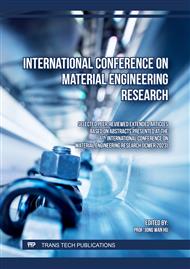[1]
F. Dif, T.H. Douara, R. Zaitri and M. Mouli. Effects of combined natural volcanic powders on the thermo-physical and mechanical properties of structural eco-concrete. J. Build. Eng., vol. 32 (2020) 101835 (.
DOI: 10.1016/j.jobe.2020.101835
Google Scholar
[2]
Ç. Meral. Use of perlite as a pozzolanic addition in blended cement production, PhD Thesis on Science, University Technique of Middle Est, 2004.
Google Scholar
[3]
R. Chihaoui, H. Siad,Y. Senhadji, M. Mouli, A.M. Nefoussi, M. Lachemi, Efficiency of natural pozzolan and natural perlite in controlling the alkali-silica reaction of cementitious materials, Journal Homepage Case Studies in Construction Materials 17 (2022) e01246.
DOI: 10.1016/j.cscm.2022.e01246
Google Scholar
[4]
T.K. Erdem, Ç. Meral, M. Tokyay, T.Y. Erdoğan, Use of perlite as a pozzolanic addition in producing blended cements, Cem. Concr. Compos. 29 (2007) 13-21.
DOI: 10.1016/j.cemconcomp.2006.07.018
Google Scholar
[5]
V.L. Tang, T.C. Nguyen X.H. Ngo, V.P. Dang, B. Bulgakov and S. Bazhenova, Effect of natural pozzolan on strength and temperature distribution of heavyweight concrete at early ages, ESCI 2018, MATEC Web of Conferences 193, 03024, pages 1-11 (doi.org/.
DOI: 10.1051/matecconf/201819303024
Google Scholar
[6]
H. Laoufi, F. Dif, T.H. Doouara, Z. Rebih, Contribution à l'étude des caractéristiques physico-mécaniques des bétons pouzzolaniques à moyen terme, Magister, ENSET Oran, 2002.
Google Scholar
[7]
O. Chaib, M. Mouli, M. Hanifi, M. Hamadache, Etude de l'influence de la pouzzolane naturelle sur la résistance mécanique des mortiers à base de ciments composes, 33èmes Rencontres de l'AUGC, ISABTP/UPPA, 27 au 29 mai 2015.
Google Scholar
[8]
M. Hamadache, M. Mouli, N. Bouhamou, A.S. Benosman, O. Chaib, F. Dif, Caractérisation des ajouts pouzzolaniques dans le mortier pour l'efficacité énergétique des bâtiments, J. Mater. Environ. Sci. 7 (2) (2016) 416-421.
Google Scholar
[9]
NF EN 197-1, Cement-part 1: composition, spécifications et critère de conformité pour les ciments, AFNOR, 2012.
Google Scholar
[10]
M. Hamadache, S. Bekheira, Z. Dali-Youcef, B. Nabil, Removal of a dye from the textile industry by adsorption on natural pozzolana, Indian J. Environ. Prot. 41 (2021) 673-680.
Google Scholar
[11]
G. Habert, N. Choupay, J.M. Montel, D. Guillaume, G. Escadeillas, Effects of the secondary minerals of the natural pozzolans on their pozzolanic activity, Cem. Concr. Res. 38 (2008) 963-975.
DOI: 10.1016/j.cemconres.2008.02.005
Google Scholar
[12]
S. Donatello, M. Tyrer, C.R. Cheeseman, Comparison of test methods to assess pozzolanic activity, Cem. Concr. Compos. 32 (2010) 121-127.
DOI: 10.1016/j.cemconcomp.2009.10.008
Google Scholar
[13]
EN 12620+A1, Sable normal et mortier normal. AFNOR, Paris, 2008.
Google Scholar
[14]
NF EN 196-1, Détermination des résistances mécaniques, in Méthodes d'essais des ciments-Partie 1: Comité Européen de Normalisation (CEN), AFNOR, Paris, France, 2006.
Google Scholar
[15]
NF EN 12390-3 (2019), Essais pour béton durci - Partie 3 : résistance à la compression des éprouvettes- Juin 2019.
Google Scholar
[16]
M. Benkaddour, F. Kazi Aoual, A. Semcha, Durabilité des mortiers à base de pouzzolane naturelle et de pouzzolane artificielle, Revue Nature et Technologie. 1 (2009) 63-73.
Google Scholar
[17]
K. Celik, R. Hay, C. W. Hargis and J. Moon, Effect of volcanic ash pozzolan or limestone replacement on hydration of Portland cement, Const. Build. Mater. 197 (2019) 803-812.
DOI: 10.1016/j.conbuildmat.2018.11.193
Google Scholar
[18]
NF ISO 15148, Détermination de coefficient d'absorption d'eau à court terme, 2003.
Google Scholar
[19]
L.H. Yu, H. Ou, S.X. Zhou, Influence of perlite admixture on pore structure of cement paste, Adv. Mater. Res. 97 (2010) 552-555.
DOI: 10.4028/www.scientific.net/amr.97-101.552
Google Scholar
[20]
Y. Senhadji, G. Escadeillas, H. Khelafi, M. Hamadache, A.S. Benosman, Evaluation of natural pozzolan for use as supplementary cementitious material, Eur. J. Environ. Civ. Eng. 16 (2012) 77-96.
DOI: 10.1080/19648189.2012.667692
Google Scholar



